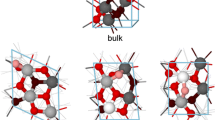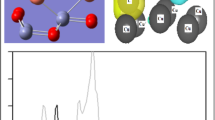Abstract
We present a theoretical study of the water gas shift reaction taking place on zirconia surfaces modeled by monoclinic and tetragonal clusters. In order to understand the charge transfer between the active species, in this work we analyze the influence of the geometry of monoclinic and tetragonal zirconia using reactivity descriptors such as electronic che − mical potential (μ), charge transfer (\( \left| {\varDelta N} \right| \)) and molecular hardness (η). We have found that the most preferred surface is tetragonal zirconia (tZrO 2) indicating also that low charge transfer systems will generate less stable intermediates, that will allow to facilitate desorption process.






Similar content being viewed by others
References
Rhodes MD, Bell AT (2005) J Catal 233:198–209
Shukla S, Seal S, Vij R, Rahman Z (2002) Nano Lett 2(9):989
Sloczynski J, Grabowski R, Kozlowska A, Olszewski P, Stoch J, Skrzypek J, Lachowska M (2004) App Catal A General 278(1):11
Tsoncheva T, Ivanova L, Paneva D, Mitov I, Minchev C, Froeba M (2009) Microporous Mesoporous Mater 120:389
Águila G, Guerrero S, Araya P (2008) Catal Comm 9:2550–2554
Aguila G, Guerrero S, Araya P (2008) Catal Comm 9:2550
Pokrovski K, Jung KT, Bell AT (2001) Langmuir 17:4297–4303
Rhodes MD, Pokrovski KA, Bell AT (2005) J Catal 233:210–220
Hertl W (1989) Langmuir 5:96–100
Korhonen ST, Calatayud M, Krause OI (2009) J Phys Chem C 112:16096–16102
Walter EJ, Lewis SP, and Rappe AM (2001) Surf Sci p. 44
Khaliullin RZ, Bell AT (2002) J Phys Chem B 106:7832
Foschini C, Treu O, Juiz SA, Souza AG, Oliveira JBL, Longo E, Leite ER, Paskocimas CA, Varela JA (2004) J Mat Sci 39:1935
Mantz YA, Gemmen RS (2010) J Phys Chem C 114:8014
Milman V, Perlov A, Refson K, Clark SJ, Gavartin J, Winkler B (2009) J Phys Condens Matter 21:485404
Herrera B, Gracia F, Araya P, Toro-Labbé A (2009) J Mol Model 15:405
Parr RG, Yang W (1989) Density Functional Theory of Atoms and Molecules. Oxford University Press, New York
Parr RG, Yang W (1995) Annu Rev Phys Chem 46:701
Parr RG, Pearson RG (1983) J Am Chem Soc 105:7512
Jorgensen CK, Electronegativy. In: K.D Sen (ed) Structure and Bonding: chemical hardness. Berly, Germany
Sanderson R (1955) Sciencie 122:207
Gutiérrez-Oliva S, Jaque P, Toro-Labbé A (2000) J Phys Chem A 104:8955
Herrera B, Toro-Labbé A, Gracia F, Araya P (2009) J Mol Model 15:405
Howard CJ, Hill RJ, Riechert BE (1998) Acta Crystallogr B 44:116
Geelings P, De Proft F, Langenaeker W (2003) Chem Rev 103:1793
Janak JF (1978) Phys Rev B 18:7165
Frisch MJ, Trucks GW, Schlegel HB, Scuseria GE, Robb MA, Cheeseman JR, Montgomery JA Jr, Vreven T, Kudin KN, Burant JC, Millam JM, Iyengar SS, Tomasi J, Barone V, Mennucci B, Cossi M, Scalmani G, Rega N, Petersson GA, Nakatsuji H, Hada M, Ehara M, Toyota K, Fukuda R, Hasegawa J, Ishida M, Nakajima T, Honda Y, Kitao O, Nakai H, Klene M, Li X, Knox JE, Hratchian HP, Cross JB, Bakken V, Adamo C, Jaramillo J, Gomperts R, Stratmann RE, Yazyev O, Austin AJ, Cammi R, Pomelli C, Ochterski JW, Ayala PY, Morokuma K, Voth GA, Salvador P, Dannenberg JJ, Zakrzewski VG, Dapprich S, Daniels AD, Strain MC, Farkas O, Malick DK, Rabuck AD, Raghavachari K, Foresman JB, Ortiz JV, Cui Q, Baboul AG, Clifford S, Cioslowski J, Stefanov BB, Liu G, Liashenko A, Piskorz P, Komaromi I, Martin RL, Fox DJ, Keith T, Al-Laham MA, Peng CY, Nanayakkara A, Challacombe M, Gill PMW, Johnson B, Chen W, Wong MW, Gonzalez C, Pople JA (2004) Gaussian 03, Revision C.02. Gaussian, Inc, Wallingford
Hay PJ, Wadt WR (1985) J Chem Phys 82:270
Hay PJ, Wadt WR (1985) J Chem Phys 82:284
Hay PJ, Wadt WR (1985) J Chem Phys 82:299
Terki R, Bertrand J, Aourag H, Coddet C (2006) Mat Sci Semicond Proc 9:1006
Korhonen ST, Calatayud M, Krause OI (2008) J Phys Chem C 112:6469
Jung KT, Bell AT (2000) J Mol Catal 163:27
Bachiller-Baeza B, Rodriguez-Ramos I, Guerrero-Ruiz A (1998) Langmuir 14:3556
Acknowledgments
This work was supported by Fondo de Ciencia y Tecnología (FONDECYT) under grants Nº 1090460 and Nº 1120093, Fondo de Areas Prioritarias (FONDAP) Project Nº 11980002 (Centro Interdisciplinario de Materiales (CIMAT)). María Luisa Cerón wants to thank Santander-Universia for a Doctoral fellowship.
Author information
Authors and Affiliations
Corresponding authors
Rights and permissions
About this article
Cite this article
Cerón, M.L., Herrera, B., Araya, P. et al. Influence of the monoclinic and tetragonal zirconia phases on the water gas shift reaction. A theoretical study. J Mol Model 19, 2885–2891 (2013). https://doi.org/10.1007/s00894-012-1706-7
Received:
Accepted:
Published:
Issue Date:
DOI: https://doi.org/10.1007/s00894-012-1706-7




